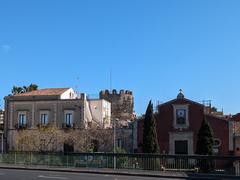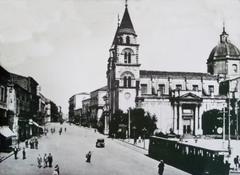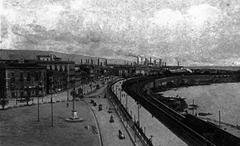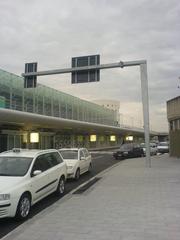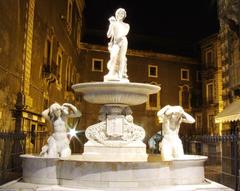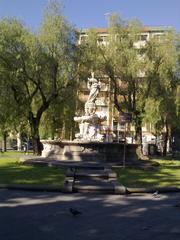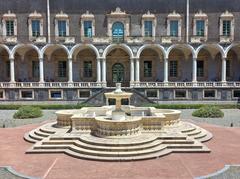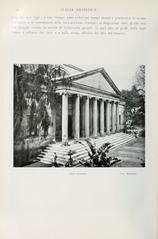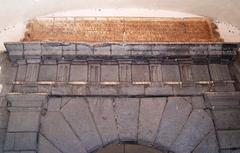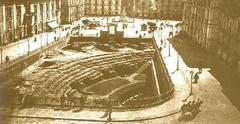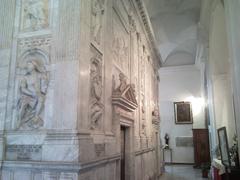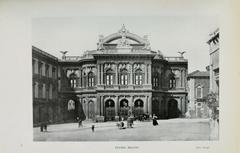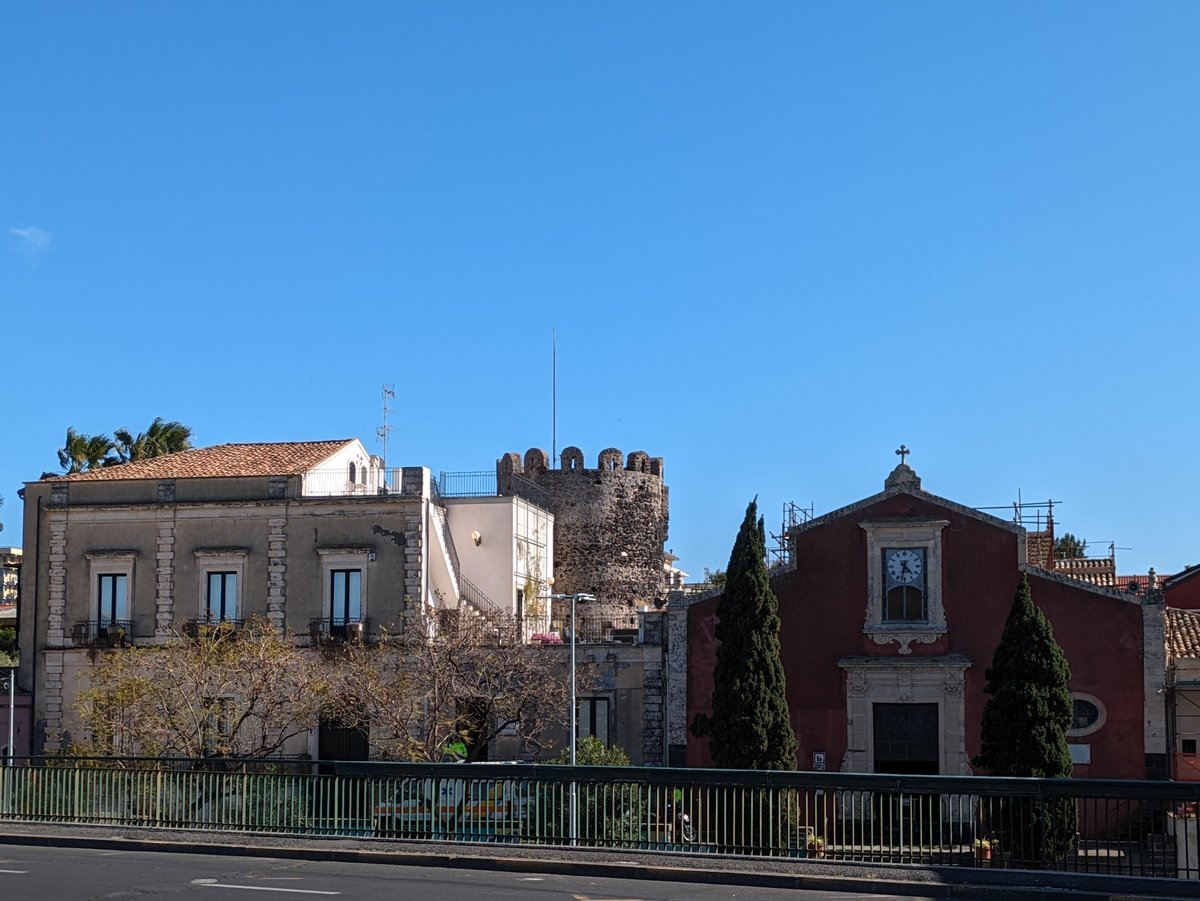
Torre di Ognina, Catania, Italy: Visiting Hours, Tickets, and Travel Guide
Date: 14/06/2025
Introduction to Torre di Ognina
Set along Catania’s northeastern coastline, the Torre di Ognina is a remarkable historic watchtower that embodies centuries of Sicilian maritime defense, local culture, and architectural adaptation. Built in 1548 under the reign of Charles V to counter pirate incursions, this tower was a linchpin in a network protecting the island’s vulnerable shores (borgodiognina.it, thesicilianway.it). Over time, the structure’s function shifted from military to religious, as it became integrated into the Church of Santa Maria di Ognina, reflecting Catania’s evolving needs.
With its robust lava stone masonry—sourced from nearby Mount Etna—and medieval defensive features, Torre di Ognina stands as both an architectural relic and a living symbol of the community, particularly celebrated during the annual Festa della Madonna di Ognina. Today, the tower is a focal point for visitors seeking to connect with Catania’s layered history, unique coastal landscape, and vibrant traditions (mondimedievali.net, etnaest.com, icastelli.it).
Contents
- Origins and Early History
- Architectural Features and Evolution
- Historical Role and Significant Events
- Visiting Hours, Tickets, and Accessibility
- Getting There and Travel Tips
- Nearby Attractions and Photo Spots
- Events and Local Culture
- FAQ: Torre di Ognina Visitor Information
- Key Historical Milestones Table
- Summary and Recommendations
- Sources
Origins and Early History
Ognina, long before the construction of its watchtower, was known as a fishing settlement with roots stretching back to antiquity (borgodiognina.it). The strategic necessity for fortification became pronounced in the 16th century as pirate raids threatened Sicilian coastal communities. In 1548, Charles V ordered the erection of Torre di Ognina as part of a broader defensive network, positioning it to oversee the small harbor and provide early warning against seaborne threats (thesicilianway.it).
Architectural Features and Evolution
Structure and Materials
The tower is constructed primarily from volcanic lava stone, lending both durability and a visual connection to Mount Etna’s dramatic landscape (borgodiognina.it). Its cylindrical form, approximately 7 meters in diameter, is characteristic of Sicilian coastal watchtowers. Key defensive features include:
- Original Battlements: Once crowned with fifteen rounded merlons, four remain today, showing the original bombato (bulging) profile.
- Arrow Slits: Narrow openings near the summit allowed for surveillance and defense.
- Machicolation: A projecting gallery above the entrance enabled defenders to drop objects on assailants.
Integration and Adaptation
Following the catastrophic 1693 earthquake, the tower was rebuilt and repurposed as the bell tower for the new Church of Santa Maria di Ognina, seamlessly merging military utility with religious function (thesicilianway.it). Further urban development has partially obscured the tower, yet its core structure remains visible and evocative.
Historical Role and Significant Events
Medieval to Modern Times
- 1356: The coastal area was the scene of a significant naval battle, underlining its strategic importance (borgodiognina.it).
- 1169, 1381: Eruptions from Mount Etna altered the coastline and destroyed ancient harbors, changing the tower’s relationship to the sea.
- 1693: The devastating earthquake led to the collapse and subsequent Baroque-style reconstruction of the church and tower.
- 19th-20th Centuries: The arrival of the railway and urban expansion integrated Ognina into Catania’s cityscape, with the tower serving as a symbol of local identity (thesicilianway.it).
Cultural and Religious Significance
Torre di Ognina is central to the Festa della Madonna di Ognina, held each September. This major religious celebration features processions, maritime rituals, and the veneration of the Madonna statue, reinforcing the tower’s role as a spiritual and communal landmark (borgodiognina.it, thesicilianway.it).
Visiting Hours, Tickets, and Accessibility
Visiting Hours
- Church Service Hours: Monday to Saturday, 9:00 AM – 12:00 PM and 4:00 PM – 7:00 PM; Sunday, 9:00 AM – 12:30 PM.
- Tower Access: The tower itself is not regularly open to the public, but its exterior can be viewed from the church courtyard and surrounding streets. Interior access may be possible by special arrangement.
Tickets
- Entry Fee: Free. Donations to the church are appreciated.
Accessibility
- The church and surrounding area are accessible, but the tower’s historic structure, including narrow stairways, may limit access for those with mobility impairments. Visitors should contact the parish office for assistance or special arrangements.
Getting There and Travel Tips
Location
- Address: Viale Artale Alagona, Ognina, Catania (icastelli.it).
- Distance: About 5 km northeast of Catania’s Piazza del Duomo.
Transport Options
- By Car: Parking is limited and mostly paid (blue lines). Peripheral lots, such as “Exchange Parking for Two Obelisks,” offer alternatives (kanoa.org.uk).
- By Public Transport: AMTS bus lines serve Ognina; tickets cost about €1 for 90 minutes (amtsct.it).
- On Foot or by Bike: The seafront promenade is ideal for walking or cycling.
Travel Tips
- Best Time to Visit: Spring and early autumn for pleasant weather and fewer crowds (championtraveler.com, nationaltraveller.com).
- What to Bring: Water, sunscreen, camera, comfortable shoes.
- Local Etiquette: Respect religious services and local routines, especially during fishing hours and festivals.
Nearby Attractions and Photo Spots
- Ognina Harbor: Picturesque setting with fishing boats and seafood restaurants.
- Lungomare di Ognina: Scenic promenade with cycling paths and views of Mount Etna.
- Catania Historical Center: Short drive to landmarks like Piazza Duomo and the Roman Amphitheater.
- Submarine Caves and Ancient Quarries: Explore natural and archaeological sites in the vicinity.
Photography Tip: Sunset and sunrise provide the best light for capturing the tower and marina against the backdrop of Mount Etna.
Events and Local Culture
In addition to the Madonna di Ognina festival in September, the district hosts cultural events, markets, and open-air concerts during summer. The area’s lively maritime culture is evident year-round, particularly in the bustling harbor and local eateries (icastelli.it).
FAQ: Torre di Ognina Visitor Information
Q: What are the visiting hours for Torre di Ognina?
A: The tower’s exterior is viewable during daylight hours; interior visits are not generally available except by special arrangement.
Q: Is there an entrance fee?
A: No, access to the exterior is free.
Q: How do I reach Torre di Ognina?
A: By car, public transport, or on foot/bike along the seafront. Parking is mainly paid; public transport is convenient and affordable.
Q: Are guided tours available?
A: Some local operators include Ognina in broader Catania tours, especially during festival periods. Check with tourism offices for current offerings.
Q: Is the site wheelchair accessible?
A: The promenade and church courtyard are accessible; the tower itself is not adapted for wheelchair access.
Key Historical Milestones Table
| Year | Event | Impact on Torre di Ognina |
|---|---|---|
| Pre-12th c | Ognina established as fishing village | Foundation of area’s strategic role |
| 1169 | Mount Etna eruption | Landscape and coastline dramatically altered |
| 1356 | Naval battle | Highlighted need for coastal defenses |
| 1381 | Eruption destroys Porto Ulisse | Loss of ancient harbor |
| 1548 | Tower constructed under Charles V | Beginning of watchtower era |
| 1693 | Earthquake | Destruction and later Baroque reconstruction |
| 1697 | Rebuilding and consecration | Addition of Baroque elements; tower becomes bell tower |
| 1830–1866 | Railway construction | Ognina integrated into expanding Catania |
| 20th c | Urban expansion | Tower becomes symbol of local identity |
Summary and Visitor Recommendations
Torre di Ognina is a captivating testament to Catania’s maritime past, volcanic landscape, and resilient community spirit (borgodiognina.it, thesicilianway.it). While direct access to the tower’s interior is limited, the district’s vibrant harbor, scenic promenade, and ongoing traditions make it a rewarding stop for cultural travelers, photographers, and history enthusiasts. Plan your visit with up-to-date information from official resources or local tour operators, and consider using the Audiala app for audio tours and event updates. Embrace Torre di Ognina as both a gateway to Sicily’s storied past and a living part of Catania’s present (etnaest.com, icastelli.it).
Sources and Further Reading
- Torre di Ognina Visiting Hours, Tickets, and Historical Guide | Catania Historical Sites, 2024, Borgo di Ognina
- Visitare Ognina Catania Borgo Sicilia, 2024, The Sicilian Way
- Torre di Ognina in Catania: History, Architecture, and Visitor Information, 2024, Mondi Medievali
- Torre di Ognina Visiting Hours, Tickets & Guide to Catania’s Historic Coastal Tower, 2024, EtnaEst
- Torre di Ognina Visiting Hours, Tickets & Travel Tips for Exploring Catania’s Historic Coastal Tower, 2024, Icastelli.it
- Parking in Catania - Kanoa.org.uk
- Best Time to Visit Catania - Champion Traveler
- When to Go to Catania - National Traveller
- AMTS Catania Public Transport
For the latest tips, event updates, and audio tours, download the Audiala app and follow us on social media. Discover more about Catania’s historical sites and Sicily’s rich heritage with our curated travel guides.
